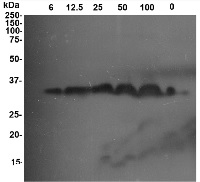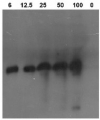1

Anti-PR-2 | GLU I | Class I beta-1,3-glucanase
AS07 208 | Clonality: Polyclonal | Host: Rabbit | Reactivity: N. benthamiana, N. clevilandii, N. tabacum, Phalenopsis, P.abies, S.lycopersicum, S. tuberosum, V. vinifera | compartment marker of vacuolar contents
- Product Info
-
Immunogen: Purified tobacco class I, basic ß-1,3-glucanase. Purified GLU I consists of a mixture of closely related polypeptides encoded by a family of GLU I genes comprising GLA B5APL3 derived from the sylvestris ancestor of tobacco, GLB P27666 derived from the tomentosiformis ancestor of tobacco and homeologous recombinants (Sperisen et al., 1991). Mature GLU I is processed from a pre-pro-polypeptide (Shinshi et al., 1988).
Host: Rabbit Clonality: Polyclonal Purity: Total IgG in PBS pH 7.4. (without Ca++). Format: Lyophilized Quantity: 2 mg Reconstitution: For reconstitution add 100 µl of sterile water Storage: Store lyophilized/reconstituted at -20°C; once reconstituted make aliquots to avoid repeated freeze-thaw cycles. Please remember to spin the tubes briefly prior to opening them to avoid any losses that might occur from material adhering to the cap or sides of the tube. Tested applications: Immunolocalization (IL), Western blot (WB) Recommended dilution: 8 µg/ml (WB) Expected | apparent MW: 37 | 33 kDa
- Reactivity
-
Confirmed reactivity: Fragaria vesca, Lactuca sativa, Nicotiana benthamiana, Nicotiana clevilandii, Nicotiana glutinosa, Nicotiana tabacum, Phalenopsis Sogo Yukidian cultivar V3, Populus sp., Solanum lycopersicum, Solanum tuberosum, Vitis vinifera Predicted reactivity: Dicots, Oryza sativa, Prunus persica
Species of your interest not listed? Contact usNot reactive in: Arabidopsis thaliana
- Application Examples
-
Application example
.jpg)
Detection of tobacco tobacco class I ß 1,3 – glucanase in ng loaded per respective well using anti- tobacco class I ß 1,3 – glucanase antibodies. Primary antibodies have been used at 8 µg/ml.
- Additional Information
-
Additional information: For more details on immunolocalization, please referr to Keefe et al (1990). Plant 182: 43-51.
This antibody can be used as a marker of vacuolar contents Keefe et al. (1990). The effect of ethylene on the cell-type-specific and intracellular localization of β-1,3-glucanase and chitinase in tobacco leave. Plant 182: 43-51.
Additional information (application): Important note: for blocking 5 % skim milk in PBS without Ca++ should be used.
This antibody is purified by affinity chromarography on Portein G.
- Background
-
Background: Pathogenesis-related (PR) proteins, are induced in response to the infection of plants with microbial pathogens. Combinations of glucanase I and chitinase I are potent inhibitors of fungal growth in vitro however precise mechanism of that is still not known. Glucanase I and chitinase I contribute to defense against fungal infection and are currently used as markers for innate immunity, and in particular the ethylene/jasmonate signalling pathway in pathogenesis. Alternative names of the protein: basic beta-1,3-glucanase
- Product Citations
-
Selected references: Shi et al. (2025). Identification of an ethylene-responsive and cell wall-secreting β-1,3-glucanase, VvGLU1, in the early cell regrowth of grape winter buds triggered by exogenous dormancy releasers. BMC Biol. 2025 Jan 23;23(1):22. doi: 10.1186/s12915-025-02120-2.
Li et al. (2021) Penicillium chrysogenum polypeptide extract protects Nicotiana benthamiana against TMV infection through modulation of ABA biosynthesis and callose priming. J Exp Bot. 2021 Mar 4:erab102. doi: 10.1093/jxb/erab102. Epub ahead of print. PMID: 33687058. (Immunolocalization)
Colman et al. (2019). Chitosan microparticles improve tomato seedling biomass and modulate hormonal, redox and defense pathways. Plant Physiology and Biochemistry. Volume 143, October 2019, Pages 203-211.
Martin-Saladana et al. (2018). Salicylic acid loaded chitosan microparticles applied to lettuce seedlings: Recycling shrimp fishing industry waste. Carbohydrate Polymers Volume 200, 15 November 2018, Pages 321-331.
Wang et al. (2014). Elicitation of Hypersensitive Responses in Nicotiana glutinosa by the Suppressor of RNA Silencing Protein P0 from Poleroviruses. Mol Plant Pathol. 2014 Sep 4. doi: 10.1111/mpp.12201.
Huey-wen et al. (2014). Harpin Protein, an Elicitor of Disease Resistance, Acts as a Growth Promoter in Phalaenopsis Orchids. Journal of Plant Growth Regulation May 2014.
Munger et al. (2012). Beneficial ‘unintended effects’ of a cereal cystatin in transgenic lines of potato, Solanum tuberosum. BMC Plant Biol. 2012 Nov 1;12:198. doi: 10.1186/1471-2229-12-198. - Protocols
-
Agrisera Western Blot protocol and video tutorials
Protocols to work with plant and algal protein extracts - Reviews:
-
| 2017-05-08Tested on sunflower and tomato total extracts prepared from seedlings obtaining excellent results in Western blots using a 1:6000 dilution.Tomasz Paw?owski | 2014-04-03We have got clear result with the class I beta-1,3-glucanaseantibody using Western blot procedure. We used 40 microgram protein/well, purified from buds of Picea abies. Antibody was diluted 1:2500 in 1,5% PBS/BSA. Secondary antibody Rabbit-AP conjugates (Sigma) was used, 1: 500 in 1% PBS/milk. FAST BCIP/NBT (Sigma) was used for detection on nitrocellulose.
Accessories

AS07 207 | Clonality: Polyclonal | Host: Rabbit | Reactivity: A. stolonifera cv. ‘Penncross’, C. annuum, N. tabacum, P. abies, S. esculentum, S. lycopersicum, S. tuberosum, V. vinifera | Cellular marker of vacuolar contents


